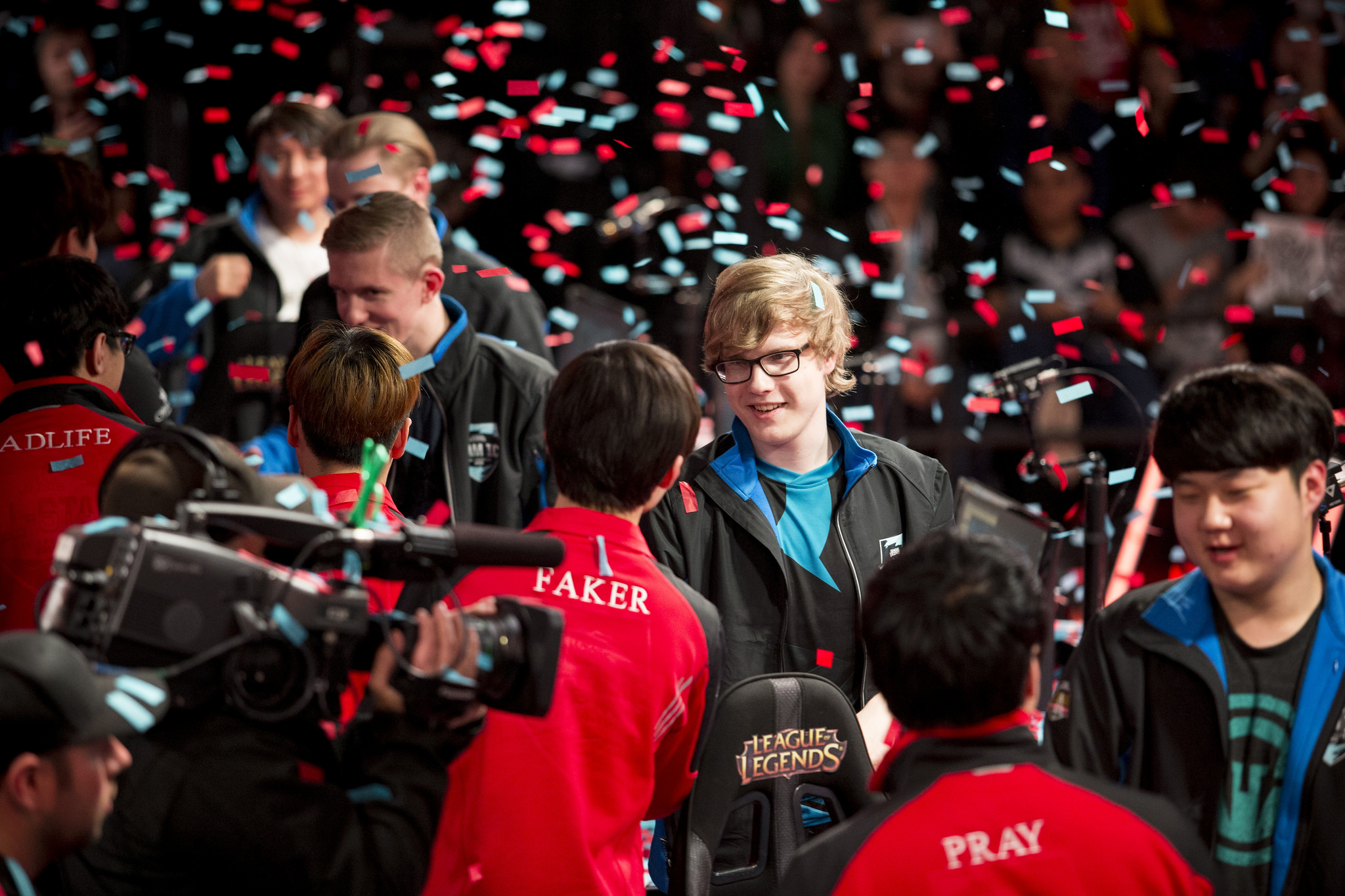Korean drama masks problems in international League of Legends

Things have finally settled down with Korea's broadcast drama. Riot announced that, as with previous years, OnGameNet TV would continue to hold broadcasting rights of the League of Legends Champions Korea circuit—the same circuit that's produced world champions three times in a row. Casters MonteCristo, Doa and PapaSmithy will return for yet another year as the best casters of the best circuit, and fans of League of Legends esports rejoice that things are as they should be.
Or, at least, mostly as they should be. The broadcasting rights drama didn't just reveal the strains and conflicts between OGN, Riot and the Korean e-Sports Association, previously obscured from the public eye—though, certainly, that absorbed much of the attention. This glimpse behind the curtain was both scandalous and tantalizing, given the rudimentary state of esports journalism thus far (we almost never get to hear about these negotiations until long after they're settled). But it also revealed some of Riot's long-term goals and how they thought it appropriate to approach them—and some of it looks a tad odd.
Attracting multiple broadcasters to cover League of Legends isn't entirely beyond the pale. After all, conventional sports has made that a long-established facet of competitive coverage. On any given week, there'll be football, baseball, soccer games across multiple channels—newspapers all over the country, rather than just one or two outlets of the enthusiast press, will report and scrutinize all on-going scores and issues. It seems pretty clear that they mean to emulate this—preventing the potential bottleneck that comes when there's only one primary broadcaster that's also the tournament organizer. For the sake of viewers and fans of specific teams, it'd make sense to expand to multiple studios and multiple channels, giving people choice and control over which matches to view and what live events to show up at.
But there were a number of problems with the implementation—first of which was whether or not the Korean circuit was large enough to demand that sort of infrastructural overhaul. Professional sports circuits like the NBA and NFL are host to 30 teams or more, and football on Sundays takes up an entire afternoon and evening bloc—so of course there are multiple broadcasters, just to make it all possible to watch. Korean esports, however, deals with less than a dozen teams all in the same city—and while overtime and best-of-fives sometimes make it so that the live audience miss the last buses out (service ends at midnight in Seoul), the broadcast schedule didn't otherwise show any significant signs of strain or compromise. With only five matches a week, OGN's single studio was doing a pretty good job of holding things down.
My confusion, on the other hand, is "why Korea?"
Yes, if Riot was planning to expand the competitive circuit and take in more teams, their single studio would've quickly gotten swamped. But this was a problem that OGN was already addressing, as it turns out. According to Erik "Doa" Lonnquist, there was already a second OGN studio under construction—one that Riot should have been aware of during the initial negotiations. The physical infrastructure was already there to allow expanded coverage under the same proven broadcaster (still assuming, of course, that future expansion is an underlying issue). Why, then, would Riot go with SPOTV?
Long-time esports fans have every reason to be worried about collaboration with SPOTV, as prior attempts to make multiple broadcasters work in Korea has been less than satisfactory. Just like the plan for LCK Summer 2016, Blizzard's Korean WCS circuit in 2013 had attempted to have two broadcasters cover the same game—the redundancy plain and simply didn't work, with most viewers defaulting to the Tasteless/Artosis English cast, failed to grow the viewer base, and ultimately just served to hinder everybody involved. It also doesn't help that SPOTV has only minimal experience with esports coverage (they're a conventional sports broadcaster), and what little history they have with competitive online gaming is marred by half-assed treatment of foreign casting talent. Though the western audience is not necessarily a significant consideration in their plans, it's telling that the inclusion of SPOTV ends up pleasing nobody.
Why include a second broadcaster at all? My suspicion is politics—bringing in competing broadcasters plays down OGN's local significance and gives Riot more leverage for future negotiations. While I don't hold to the conspiracy theory that Riot's trying to weaken Korea's competitive dominance (I know for a fact that much of the esports department is as much of an LCK fan as anybody else), I do think there are circumstances where Riot's willing to pull rank to make things easier for themselves on the business level. It's perhaps cutthroat (and offensive to the sensibilities of its young and business-illiterate audience), but it isn't entirely unreasonable to maneuver this way. My confusion, on the other hand, is "why Korea?"
The biggest gaming news, reviews and hardware deals
Keep up to date with the most important stories and the best deals, as picked by the PC Gamer team.
While OGN, KeSPA and Riot tussles over the operating terms of the world's most successful League of Legends circuit, the world's richest circuit is seemingly left alone. Wang Sicong, son of the richest man in China, is known for many things—public antics like snapping up two Apple Watches for his dog, or burning US $30,000 in a single night out in Beijing, but also as an esports heavyweight as the owner of Invictus Gaming. Most recently, he's bought out the broadcasting rights for China's League of Legends Pro League.
If there was any circuit that probably needed multiple broadcasters, it would've been China with its infamously overloaded competitive schedule—two or three times as many games as any of its peers. But instead of diversifying to meet broadcasting demands, the LPL has now been folded wholesale into Wang Sicong's Banana Plan production company, along with the technically third-party Demacia Cup. It's pretty clearly a conflict of interest to own both the production of the competitive circuit and a stake in a competing team's outcome—but the silence from Riot regarding the Chinese broadcast situation has been deafening.
Similarly, their interference with a circuit that's already proven self-sustaining comes at sharp contrast to circuits that aren't. There have been no announcements of further involvement in the Taiwanese LoL Master Series, despite their successes this year—no suggestions at all that they plan to enhance its shoestring budgets, invest in English casting, or help attract non-endemic sponsors to the neglected stepchild of the premier circuits. No news either that Southeast Asia'll be expanded upon—which might not be entirely surprising, given that the creation of the LMS was pretty much a direct snub at SEA's shoddy infrastructure, but the silence on SEA matches that of the other "near-premier" circuits like in Turkey, Brazil and Oceania.
It's not hard to understand why the community would think that Riot's picking on Korea when Korea's hogging all the post-Worlds spotlight. The only circuits that don't seem neglected in comparison are the NA and EU LCS—both of which will be undergoing an experimental phase in summer 2016, much to the chagrin of EU fans in particular (by the way: best-of-two is ideal for the group stage, guaranteeing balanced experience on both sides of the map. Complaints about EU getting fewer games than NA ignore the quality of the matches involved).
I'm certainly hoping that my impressions of Riot's neglect of the other international circuits is in error—but I'm an LMS fan, so I'm used to hoping in vain.

PC Gamer Pro is dedicated to esports and competitive gaming. Check back every day for exciting, fun and informative articles about League of Legends, Dota 2, Hearthstone, CS:GO and more. GL HF!

